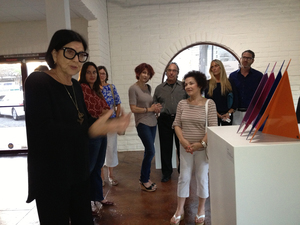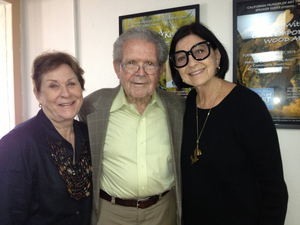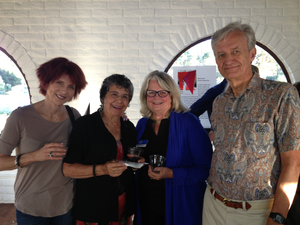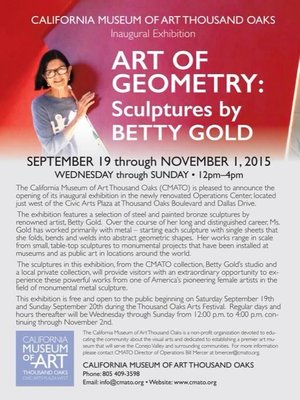Art of Geometry: Betty Gold
September 19, 2015 - November 1, 2015
Artist Statement:
My inspiration comes from many directions, experiences and channels, but my work always begins with the simple act of folding paper. I create a flat, rectangular structure, deconstruct the parts and reassemble them into the whole, then create a set of drawings and geometric models based on the linear geometry of rotating movement.
From a basic set of shapes, I design several different models - or maquettes – then build them in steel and choose which piece integrates best into the commissioned landscape. The maquette also provides the visual and architectural reference needed to scale the work to its monumental dimensions. I still continue to personally oversee construction and site preparation for each of my installations to ensure the rigid-quality standards I’ve upheld throughout my 45-year career as a professional artist.
My continuing goal is to create art that brings a sense of joy and imaginative flight to those who engage with it, and that will endure long into the future. I also hope to motivate, represent, and inspire more women sculptors to assert themselves into the competitive art market, where they’ve yet to become dominant members.
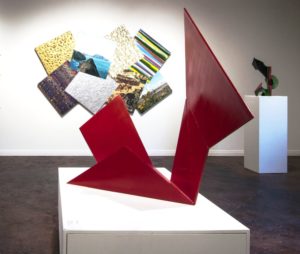 The Betty Gold exhibition features a selection of her signature steel and painted bronze sculptures. Over the course of Gold’s distinguished career, she has worked extensively with metal – starting each sculpture with single sheets that she folds, bends and welds into abstract geometric shapes. Her works range in scale from small table-top sculptures to monumental projects that have been installed at museums, universities and as public art in locations around the world.
The Betty Gold exhibition features a selection of her signature steel and painted bronze sculptures. Over the course of Gold’s distinguished career, she has worked extensively with metal – starting each sculpture with single sheets that she folds, bends and welds into abstract geometric shapes. Her works range in scale from small table-top sculptures to monumental projects that have been installed at museums, universities and as public art in locations around the world.
After painting for 14 years, Gold was invited by a friend to a sculpture class with Texas artist Octavio Medellín at the Texas Trade Welding School. In class she began by creating metal figures and eventually became Medellín’s assistant. Gold began in clay sculpture, drawing her own patterns on architectural paper. Later she would lay out big patterns, and the factory would cut them out in large plastic sheets. From those sheets, she cut and welded and often painted her metal sculptures.
The sculptures in the inaugural exhibition are from the CMATO permanent collection, Gold’s studio, and loans from private collections. The exhibition will provide visitors with the extraordinary opportunity to experience powerful works from one of America’s pioneering female artists in the field of monumental metal sculpture.
Gold also continues to paint and photograph. Her studios are in Venice, CA and Santa Fe, NM.
ABOUT THE ARTIST
Betty Gold was born in 1935 in Austin, TX. She attended the University of Texas with a major in Elementary Education and a minor in Art History. After completing her studies, she entered the tutelage and apprenticeship of sculptor Octavio Medillan in Dallas.
 “I’ve been asked many times to explain my art, but I don’t think that there is an explanation, as such. I can say, however, that I began with the human figure and ended up with geometry, which I love. It’s not an easily understood transition, or even one that I fully comprehend. Suffice to say that I don’t think it will shed more light going beyond Picasso’s simple but profound reflection that “It’s the leap of the imagination.”
“I’ve been asked many times to explain my art, but I don’t think that there is an explanation, as such. I can say, however, that I began with the human figure and ended up with geometry, which I love. It’s not an easily understood transition, or even one that I fully comprehend. Suffice to say that I don’t think it will shed more light going beyond Picasso’s simple but profound reflection that “It’s the leap of the imagination.”
With the exception of some photographic work, everything I have done for the major part of my career has been based on a geometric concept. It never becomes tiresome and I continue to find new ways in which to express its truth and universality. Every new project is like the first: challenging, fulfilling, and exciting.”
Since 1959, Gold has traveled extensively, studying and lecturing around the world and taking inspiration from the diverse cultures she has observed. Her works are in private and public collections in the United States and Europe and her large outdoor sculptures are in permanent installations in Spain, Europe, Eastern Europe, Japan, Ireland, South Korea, Mexico and the United States.
MADI MOVEMENT
MADI is a movement founded by Carmelo Arden Quin. During the 1940’s Arden Quin joined intellectual writers and artists in Buenos Aires . In 1944, after working on it for several years, he brought out the literary and artistic journal Arturo, in which he applied dialectic materialism of art. The movement was conceived as a combination of Futurism, Cubism and Constructivism with a touch of Quin’s own artistic philosophy, as a reaction to the dictatorship of Juan peron. Arden Quin wanted artists to express themselves in abstract forms and terms Peron’s regime wouldn’t be able to censor or twist into government propaganda.
In August of 1946 Arden Quin read to the public the MADI Manifesto, which he had written, and which launched the MADI movement. He began experimenting with curved wood, alternating convex and concave forms, which he called “form galbee” and irregular shapes.
MADI-is commonly accepted to mean “movement, abstraction, dimension and invention” It’s a movement that delves beyond painting and sculpture into free-form poetry, theater, books, music and dance.
The MADI Movement continues today through original artists from the movement encouraging younger artists to adopt the MADI mentality and is represented by artists internationally as well as in North America.
MADI emphasizes innovative designs containing an array of geometric forms. The concept behind MADI is more than just an assembly of colored shapes, however – the art is universally accessible and appealing, and the more it is studied, the more multifaceted it becomes.
Sources:

